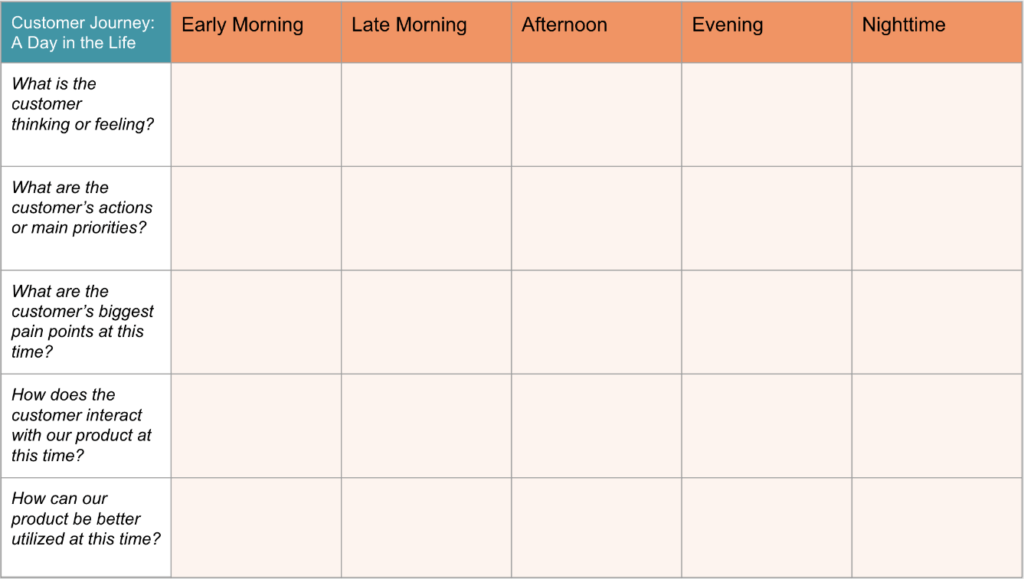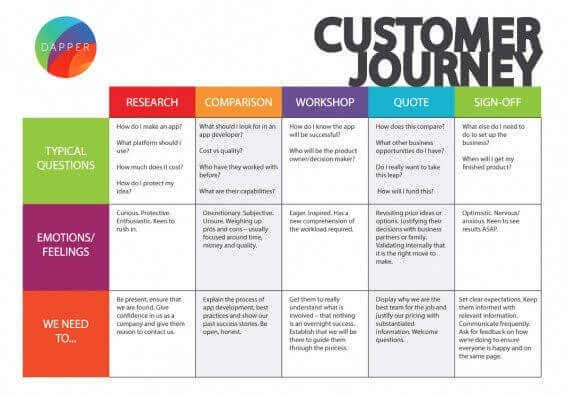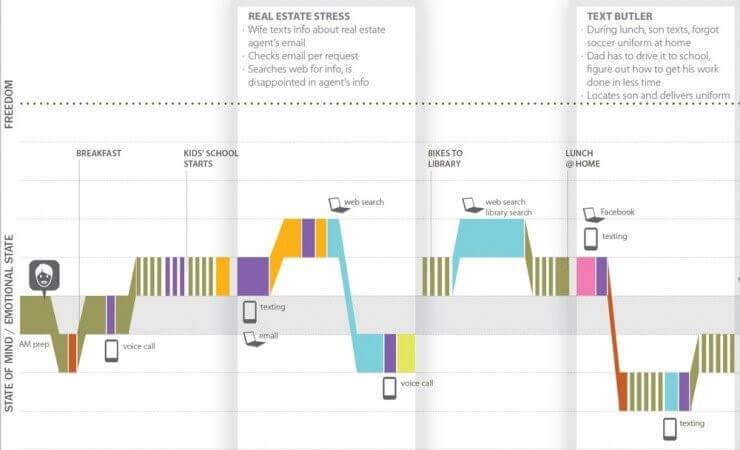Around 56% of customers interact with business through numerous platforms online and have various milestones in the journey to buy a product. When a business uses a customer journey map(1) it can lead to discovering what doesn’t work and implementing changes that lower service costs by up to 20%. So, what is a customer journey map?
What is a customer journey map?
In layman’s terms, a customer journey map is sort of like a storyboard for businesses. It helps to see things from the perspective of the customer in terms of interaction with businesses through various social media platforms, customer service, wants/needs, etc. from the first interaction to last, that happens in a non-linear way.
How to create a customer journey map
Here is a list of what one needs in order to create a customer journey map:
-
Establish purpose for your customer journey map
- Know what you want to learn from your customers using a customer journey map
- Understand the stages of customer interaction.
- Research: A consumer becomes aware of a need/want that they have, so they embark on a research journey to find a product and/or service that can potentially solve their problem.
- Interaction: After thorough research, the consumer finds a business that they assume can address their specific needs and start interacting with said business online through social media platforms, apps, and their main website.
- Evaluation: Getting further acquainted with the brand will let the consumer know if it will absolutely be a right fit to do business with.
- Purchase: At this moment, the consumer will either decide to purchase or not purchase a product/service the business is offering.
- Experience: The consumer finally gets to use the product and if they are satisfied with the results it can lead to…(drumroll).
- Loyalty: The happy consumer becomes attached to the brand and the service a business provides, which can lead to more customers through positive reviews online and recommending the business to others.
-
Figure out what you want to know about your customers
- Create profiles or personas of your customers
- Figure out the target demographic of the people who buy your products or use your services
- Document the touchpoints (digital platforms) customers use to interact with your business
- Record customer thought and actions word-for-word
- Figure out the pain points (specific problems) that the customer has
- What emotions are the customers feeling throughout this process
- Look for ways to improve customer interactions
- Look for moments of truth
-
Figure out the specifics of what you want the customer journey map to cover:
- Establish a beginning and ending to the research process
- Figure out the goal of the customer
- Study the customers’ behaviors and habits
- Understand that this map is to show the perspective of the customer
- Map current and future states for a comprehensive insight into how customer interactions are compared to how a business wants them to be
-
Try to find missteps in the journey
- Does each map focus only on customer?
- Does it document customer interaction across all platforms (touchpoints)?
- Does it include both anecdotal and analytical information?
*Platforms like Google Analytics, Qualaroo, and Crazy Egg can be used to gather the demographic and behaviors of the customers (personas) in an analytic way to simplify the metrics of the anecdotal data and to see improvement gaps that can be corrected during the customer interaction process.
– Are turn-ons/turn-offs included (moments of truth)?
– Are there any ideas for better customer interaction from those moments of truth?
Once all data is collected, document them in a table graph, analyze the data, then complete any adjustments needed to improve consumer-to-business interactions.
Why Should You Use A Customer Journey Map?
The process of using a customer journey map can be extremely helpful in showing a business how its operations runs from the outside. The information that can be gained from customer-to-business interactions can be crucial to a business creating a better relationship with the customer and in turn attracting more potential customers in the future.
A business can see its operation from the eyes of the customer through an inbound point of view. Attracting customers through an inbound perspective is basically just creating content to cater to the needs of the customers by offering a solution to a problem. Thus, a business can see if its tactics are effect with reaching the other side by engaging & communicating with its customers.
Not only can a business interact with its customers, it can create new ones. A customer journey map helps to break up the customer base into categories like demographics and customer behaviors. During the process, a specific audience can be targeted, needs from that audience can be specified, and marketing strategies can be tailored to target that audience.
Large businesses can have a hard time with organizing a way to prioritize the customer when there are multiple departments within the same company trying to come up with a strategy to reach out to said customers. With a customer journey map, the information gathered (from first interaction to purchasing the product) can be shared across the customer service, marketing, and sales teams in order to focus on what the customer truly desires.
Also Download – Whitepaper ( Customer Journey Mapping Shows the Way )
Here’s How A Customer Journey Map Works
When it comes to using a customer journey map, one must know the main components of a good customer journey map which are:
- Customer personas (bio & demographic breakdown)
- A timeline (a beginning and end)
- Emotions (customer’s emotional journey)
- Touchpoints (digital platforms used in customer interaction)
- Channels (the exact places where interactions took place)
Once a good map is created, then you can finally get to use it and to experience the process of how it works.
-
Go over your goals
- Describe the map’s what relevant
A business must make sure that it not only knows the goals of the participating in the customer journey map, but to also know the goals of the business as a whole.
-
Document findings
- Lay out the information
Go over both anecdotal and analytical data that has been collected to gain perspective to in customer-to-business interactions. Collect more research data through interviews, surveys, and data collection websites, if needed.
-
Have a Think Tank for Touch points & Channels
With a team, make a list of touchpoints & channels that the customer uses in the customer interaction process and think about possible touchpoints and channels that could be used in the future. An example of the connection would be at the top of a business’ website, there is a tab called “About Us” (touch point). Then, at the bottom of the page there is a clickable button called “Contact Us” (channel).
-
Empathy Map
- Create a back story of the customer & map out thoughts/feelings
Organize of the documentations of what the customer is thinking, feeling, and seeing in order to explore the persona of the customer in various aspects of the customer interaction process.
-
Have a Think Tank with Lenses
Try to come up with as many ideas as possible for a lense word within a 2-minute window. Lenses are wording that represent important concepts that encourages one to look at a situation or issue in a different light. This is best done in a small team, where each person can come up with a variety of ideas and get their voices heard.
-
Affinity Diagram
Begin to organize the ideas that were created during the lense think tank activity into a visual diagram to categorize and label them. Then consider changes to the interaction process, as a group, to get on the same page as to what is the best strategy for future customer interactions.
-
Map out the Journey
- Include emotional experiences, pain points, & thoughts /feelings
Create a rough draft of the research data from the main components of a customer journey map with the new ideas for better customer interactions thought out by the team and flesh it out. The lay out doesn’t have to be perfect. It can be drawn out like a timeline or a bubble graph. It can be done on a piece of paper or a computer.
-
Work out the Kinks & Digitize
When it all starts to come together, start to think about polishing the map by choosing a visual diagram to put all the information in to not only be appealing to the eye, but to make all of the data collected easy to interpret.
-
Show & Implement
- Look at the big picture
Once the visual diagram of the customer journey map is shared throughout all sectors of a business the journey doesn’t end. From there, one can continue to use the map created to collect more data on customer interaction for longer periods of time (quarterly/yearly). This can serve to implement tailored strategies to improve customer interaction.
Types of Customer Journey Map
There’s no one type of business. So, in turn, there are multiples types of customer journey maps that can be used to collect consumer data. Current state, Future state, Day in the life, Competitors map, Service blueprint, and Buyer’s journey. are all the types of customer journey maps that can be used to find out the goals of the consumer. In this article, we’ll only expound upon the first four.
A Current State Template collects a consumer’s thoughts, feelings, behaviors online, touchpoints, and changes that can be made to make interactions better. An example of the use of this template will show the phases of the customer process of researching a business to what happens after the product is bought. The information that is being gathered is to ultimately implement possible changes that can be made to make interactions between buyer & producer better.
A Future State Template is like a current state template, except that it’s used to predict future actions that a consumer might make based on want, competition, and unrequited wants & needs. Use of this template documents what a business wants the customer journey (from research to post purchase) to look like, instead of what is happening in the current moment.
A Day in the Life Template follows the consumers’ actions and feelings daily to learn about their buying/spending habits. An example of this template documents customer interactions in chronological order daily (morning, noon, evening, and night).

The Competitor’s Journey Map Template basically uses the process of scoping out other competing businesses for information about their strengths, weaknesses, advantages, and disadvantages when interacting with their consumers.
Benefits of Customer Journey Mapping
- Making connections amongst different departments within a business (marketing, sales, & operations)
- Getting to know the customers better
- Establishing a connection with the customer on an emotional level
- Acknowledging any flaws within the customer interaction journey and correcting them with better touch points
- Being able to better foresee the behaviors of the customer and the success of a business as a whole
Challenges of customer journey mapping
- Maps have a set time limit, while journeys are never-ending
- A single map can only focus on one journey at a time
- Maps are about the overall journey, not just specific emotions and standards of the customer
- Different strategies in dealing with moments of truth and pain points are required
A Checklist For Your Finished Journey Map
There are a variety of questions that a business can ask itself once the journey is complete. What was studied/gathered, interactions with touch/pain points, moments of truth, & improvements?
A customer journey map isn’t the only way to document the experiences of the average person. Empathy, experience, and service mapping are commonly used visual tools to connect the document to the behaviors of the average consumer.
Customer Journey Mapping Examples
1. HubSpot’s Customer Journey Map Templates
2. B2B Customer Journey Map Example
3. Ecommerce Customer Journey Map Example
4. Future B2C Customer Journey Map Example
5. Retail Customer Journey Map Example
Difference Between Customer Journey Map and Experience Map
| Customer Journey Map | Experience Map |
|---|---|
| Definition: The documented journey a consumer goes through to accomplish a goal in relation to a specific business or product | Definition: It has nothing to do with the business aspect of documenting consumer behavior but it focuses only on what the “average” consumer does to fulfill a want and/or need |
| Characteristics: Tied to the relationship between business and consumer. Has 4 categories: phases, actions, thoughts, mindsets/emotions. Chronological but non-linear. A single visual is about a single experience. Mainly about the consumer’s perspective: Includes mindset, thoughts, and emotions | Characteristics: Has nothing to do with products or services. Has 4 categories of use: phases, actions, thoughts, mindsets/emotions. Studies human behavior for general purposes. Documents events in chronological order (linear) |
| Use: To figure out a consumer’s wants and needs. Help a business create a unified front in how to reach out to its consumers. Establishes what the important questions are | Use: Used to understand human nature/habits. Single visual can contain multiple experiences |
| When to enact use: At any time | When to enact use: Before creating a customer journey map. Combines multiple experiences into one |
Final Thoughts
Having these specific elements in your customer journey map ensures a non-biased, full-fledged insight into consumer-to-business interactions. In order for a business to grow and mature as a brand, there has to be serious introspection about how it operates to fulfill the needs and solves the problems of the average customer.
***
Kierra Benson is an alumnus of the University of North Texas at Dallas with a Bachelor’s degree in Communication and Technology. She previously completed an internship at a local newspaper and worked as a content creator for a small online business. Her goal is to work in the media industry in writing/editing and advertising. She has always been fascinated by how messages are marketed in the media to influence the masses and sell products. Connect with her on LinkedIn.














